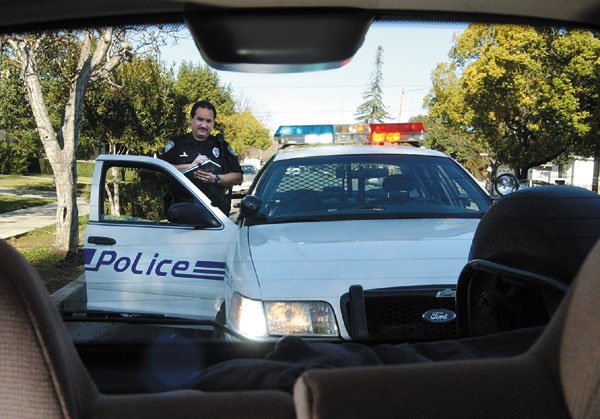Gilroy – Nestor Quinones may be the least popular cop in Gilroy,
but you wouldn’t know it as he stands alongside Monterey Highway,
chatting with the driver he’s stopped. Two kids squabble in the
backseat as Quinones smiles, and hands her a speeding citation.
Sure, the driver admits, she was speeding. With these bickering
kids in the backseat, wouldn’t you?
Gilroy – Nestor Quinones may be the least popular cop in Gilroy, but you wouldn’t know it as he stands alongside Monterey Highway, chatting with the driver he’s stopped. Two kids squabble in the backseat as Quinones smiles, and hands her a speeding citation. Sure, the driver admits, she was speeding. With these bickering kids in the backseat, wouldn’t you?
“No one likes getting a citation – so the traffic officer isn’t someone you like,” he says later, dishing about the job over a burrito. At a Fifth Street taqueria, line cooks greet him, grinning; other officers wave from a nearby table.
Despite what he does, Quinones seems pretty well-liked.
“Some people are just upset at you, and there’s nothing you can do,” he says. “But I’m doing a job, to protect the city of Gilroy.”
As police work goes, Quinones’ new job isn’t glamorous. Few people land behind bars for traffic tickets, and aggravated drivers often unload their rage on the officer who’s stopped them. Quinones has to keep pace with the labyrinthine Vehicle Code, with its ever-shifting, nitpicky subsections. And it’s surprisingly dangerous: nationwide, nearly half of officers killed in 2005 died during traffic stops.
Quinones shrugs it off. He’s not hung up on accolades, or even on being liked. Yet he brings a human touch to the job, an ease with people that emerges when he spins a mundane story into a rib-tickling tale, as he points out a local daycare from the road. Raised in nearby Modesto and distant Colombia, he’s not only bilingual but also biliterate, joking readily in both English and Spanish.
“You can’t go out there and be a robot” on this job, said Sgt. Kurt Svardal. “Nestor’s very firm, but polite. He can deal with people so they’re not walking away teed off.”
And even if they don’t like him, after a spate of pedestrian deaths in Gilroy, residents are beginning to look on him with new respect. Gilroy hasn’t had a dedicated traffic officer since 2005, when Joseph Crivello was promoted out of the job. It wasn’t until three lives were lost on Gilroy streets – two of them young boys – that concerned residents clamored for a new traffic officer.
“Before, people didn’t get that there was a problem,” said Quinones. “But there’s definitely a problem when two little kids are run over.”
Stretched for staff, the department couldn’t spare a specialized officer until this month. Quinones started the beat this Monday, one of only two officers who put their names in for the job. Assistant Chief Lanny Brown says his presence will definitely be felt on Gilroy streets: Though all officers halt speeders and write tickets, Quinones will be deployed to problem areas reported by residents, from renegade parking to stop-sign scofflaws.
“The stuff you see, we might not,” Quinones says. “Those complaints help us know where to go.”
For now, he’s behind the wheel, but by spring, he’ll be patrolling the streets on the department’s only motorcycle: In March, he’ll learn safety tips and two-wheeled tricks at motor school. Quinones has ridden motorcycles since he was 18, he says, but he expects to wipe out at motor school nonetheless, trying to master quick turn-arounds and other new skills. He’ll join reserve officer Benjamin Charnota, who began tracking Gilroy speeders by bike this month.
“Nestor’s very tenacious when it comes to traffic enforcement,” said Sgt. John Sheedy. “If the citizens of Gilroy haven’t already noticed, they’ll see very soon that a traffic officer is back on the streets.”
Quinones takes the much-maligned job after holding the beloved position of canine officer. Kimbo, his dog, retired after nine years on the job this January. Previously, Quinones worked on the department’s SWAT team. He’s spent 12 years at the department, and has committed to a three-year stint as traffic officer.
It’s hard for him to remember a time he didn’t want to be a police officer, Quinones says. As a kid in Modesto, he glowered as bullies threw their weight around; as a teen in Colombia, he grew frustrated by the militaristic, bribe-hungry police. It’s different in the U.S., his parents told him. Quinones wanted to be that difference.
Today, he balances being firm with being fair. Trolling for speeders alongside Monterey Highway, he doesn’t nail the scattered drivers whose speed creeps just over the limit, but waits for those who barrel down the road far too fast. He rests a radar gun against the door. It bleats and drones, catching the speeds of the passing cars: speeds Quinones can eyeball just as easily. After watching cars for a while, he says, he’s become attuned to speed, can pick out who’s traveling 40 miles per hour, who’s traveling 50.
He uses the radar gun anyhow, just in case drivers counter him.
“I’ve heard all kinds of excuses,” Quinones said. “Going to the emergency room. Needing to go to the bathroom. Claiming, ‘It wasn’t me!’ when they’re the only one on the road.”
For another officer, fending off excuses, gripes and road rage might get tiresome. But Quinones keeps his cool, no matter how heated a traffic stop might become.
“I present it to them as nicely as I can,” he says. “You know it’s going to ruin their day.”















